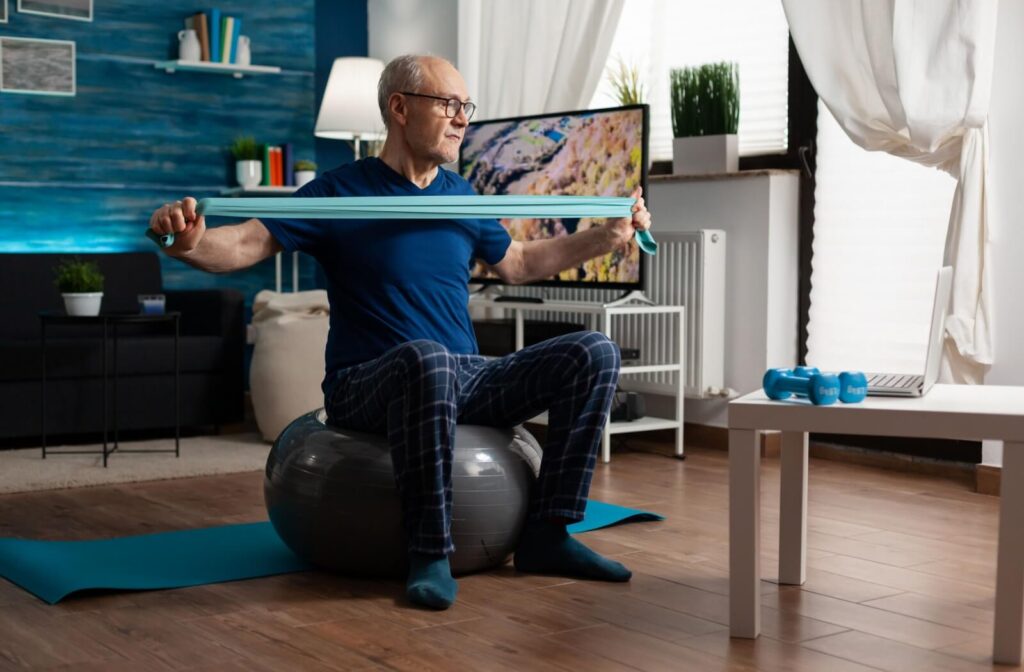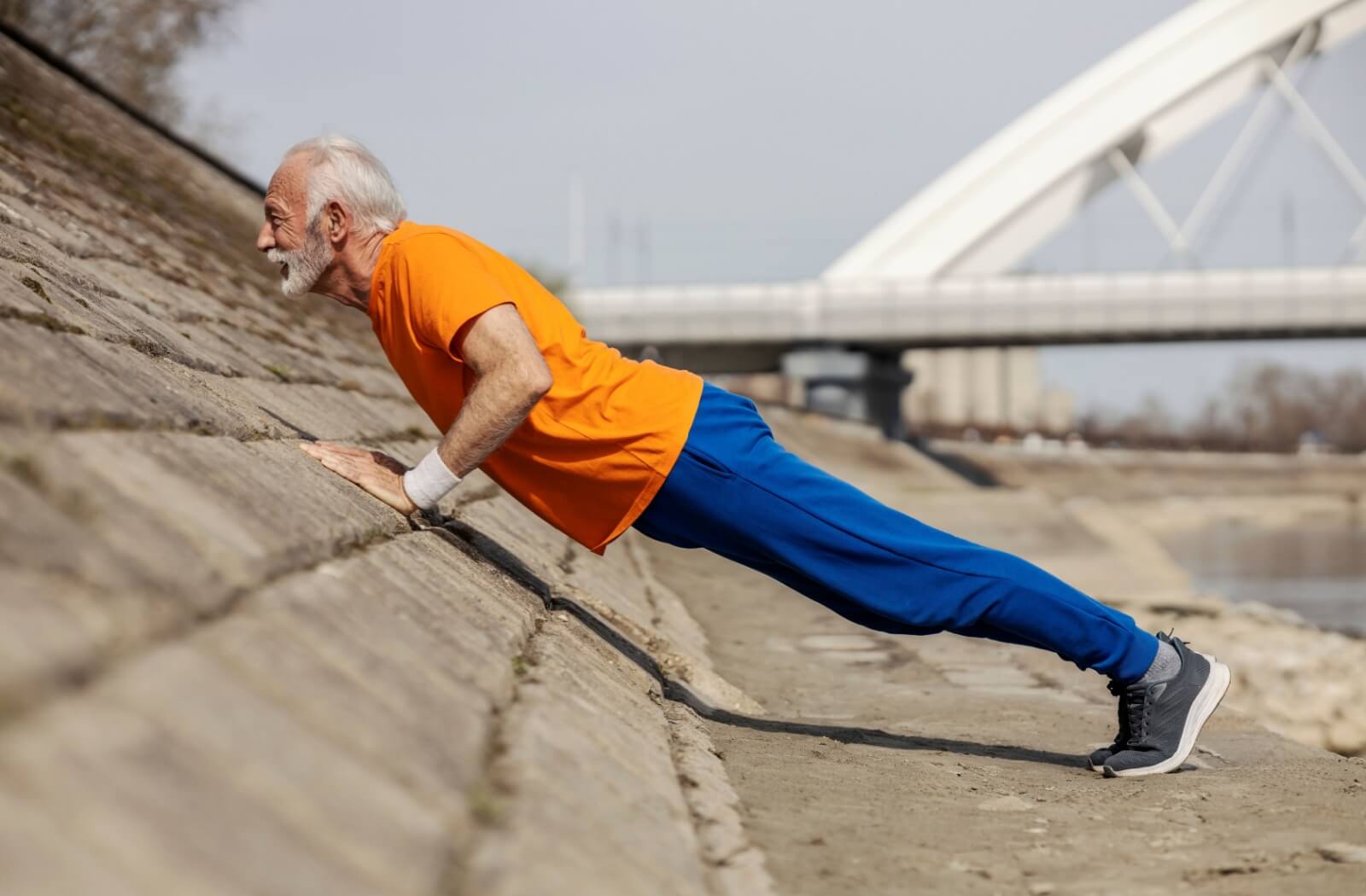Key Takeaways
- Exercise helps strengthen bones, improve balance, and reduce fall risk for seniors with osteoporosis.
- Walking, sit-to-stands, heel raises, wall push-ups, and leg lifts are easy daily exercises.
- Gentle yoga, tai chi, and resistance band exercises build flexibility and strength.
- Safe, consistent movement supports independence and overall well-being.
7 Great Osteoporosis Exercises for Seniors
Osteoporosis weakens bones, but the right exercises can build strength, improve stability, and help prevent falls. For seniors, movement doesn’t need to be complicated or high-impact to be effective. 7 exercises that are great for seniors with osteoporosis include:
- Walking
- Sit-to-stands
- Heel raises
- Wall push-ups
- Standing leg lifts
- Gentle yoga or tai chi
- Resistance band exercises
Together, these activities strengthen bones and muscles, improve balance, and encourage independence for older adults.
Assisted living communities often offer wellness programs and exercise programs designed to help seniors thrive despite health conditions or lifestyle.
What Is Osteoporosis?
Osteoporosis is a condition that causes bones to become weak and brittle over time. It occurs when the body loses too much bone mass, doesn’t make enough new bone, or both. For seniors, this means even a minor fall or bump can lead to fractures, especially in the hips, spine, and wrists.
The condition is often called a silent disease because bone loss happens gradually and without symptoms. Many people don’t realize they have osteoporosis until they break a bone. That’s why prevention and management are so important.
While risk increases with age, there are steps seniors can take to protect bone health. Exercise, combined with good nutrition and medical care, plays one of the most powerful roles in slowing bone loss and maintaining independence.
Why Is Exercise Important for Osteoporosis?
Staying active helps manage osteoporosis and can lower the risk of fractures in the hips, spine, and wrists. Exercise also supports better posture, flexibility, and confidence. Beyond bone health, it provides social interaction, boosts energy, and improves mood.
How Does Walking Support Bone Health?
Walking is a simple weight-bearing exercise that strengthens bones in the legs, hips, and spine. Even short daily walks can improve circulation and stability.
Tips for Safe Walking
- Wear supportive shoes with non-slip soles.
- Break walks into shorter sessions if needed.
- Walk with a friend for safety and encouragement.
How Do Sit-to-Stands Help Seniors with Osteoporosis?
Sit-to-stands mimic the everyday movement of getting out of a chair, which strengthens thighs, hips, and core muscles.
How to Perform Sit-to-Stands
- Sit in a sturdy chair with feet flat on the ground.
- Cross arms over the chest or hold the chair for support.
- Stand up slowly, then sit back down with control.
Aim for 10-15 repetitions.
Why Are Heel Raises Good for Balance?
Heel raises build calf strength, which helps with posture and stability—critical for seniors trying to prevent falls.
How to Do Heel Raises
- Hold onto a counter or chair for support.
- Rise onto your toes, lifting heels off the ground.
- Lower back down slowly.
Repeat 10-15 times.
Can Wall Push-Ups Build Upper Body Strength?
Yes. Wall push-ups are a safe, senior-friendly way to strengthen arms, shoulders, and chest without strain. These muscles support daily tasks like lifting or carrying.
Steps for Wall Push-Ups
- Stand two feet from a wall, hands at shoulder height.
- Bend elbows, lowering your body toward the wall.
- Push back to start position.
Do 10-12 repetitions.
Why Are Standing Leg Lifts Important for Seniors?
Strong hips lower the risk of falls and fractures. Standing leg lifts strengthen the hips and glutes, improving balance.
How to Do Standing Leg Lifts
- Stand behind a chair for support.
- Slowly lift one leg to the side, keeping your back straight.
- Lower and switch sides.
Repeat 8-10 times per leg.

Is Yoga or Tai Chi Safe for Seniors with Osteoporosis?
Gentle yoga and tai chi are excellent for flexibility, posture, and balance. These low-impact practices also reduce stress and improve coordination.
Simple Movements to Try
- Cat-cow stretches for spine mobility
- Tree pose for balance
- Seated twists for flexibility
Look for senior-specific classes in Raynham or practice at home with modifications.
How Can Resistance Bands Help Strengthen Bones?
Resistance bands are lightweight and versatile tools that build strength without heavy weights. They’re especially useful for seniors with osteoporosis.
Examples of Resistance Band Exercises
- Seated rows to strengthen the back
- Bicep curls for arms
- Side steps with a band for hips and thighs
Start with a light band and increase resistance gradually.
What Safety Tips Should Seniors Follow Before Exercising?
To prevent injury, seniors with osteoporosis should keep these safety guidelines in mind:
- Consult a doctor before starting new exercises.
- Avoid high-impact movements like jumping or running.
- Use sturdy support like chairs or rails when needed.
- Stop if you feel pain beyond mild soreness.
Stronger Living at All American Assisted Living
Stronger Living is All American Assisted Living’s personalized health and wellness program, created to meet the unique needs of every resident. With a full-time expert staff, year-round services, disease-specific programming, and flexible delivery through group or one-on-one options, the program ensures residents always receive the support they need.
How Does Stronger Living Work?
Stronger Living focuses on helping residents manage specific conditions through physical, occupational, and speech therapy. The program addresses eight of the most common health challenges seniors face, including:
- Arthritis
- Joint replacement recovery
- Diabetes
- Dementia
- Deconditioning or inactivity
- Cerebrovascular accident or stroke
- Cardiac issues
- Parkinson’s disease
Each Stronger Living plan is designed around 5 key goals. The program works to improve overall health and wellness, increase and maintain strength, and prevent further injury, falls, and other health risks. It also helps manage the risks associated with chronic conditions while supporting each resident’s ability to maintain independence.
This holistic approach allows residents to stay active, supported, and confident—whether they’re working to manage osteoporosis, recovering from surgery, or simply staying fit.
Thrive, Even with Osteoporosis in Raynham
Osteoporosis doesn’t mean slowing down—it’s about finding safe, effective ways to keep moving with confidence. The exercises highlighted above, combined with the personalized support of our Stronger Living program, give seniors the tools they need to build strength, improve balance, and maintain independence.
At All American Assisted Living at Raynham, residents benefit from a community where wellness is part of everyday life. From group exercise classes and walking clubs to one-on-one therapy sessions, we provide opportunities for every person to stay active at their own pace.
If you’re seeking a welcoming community in Raynham that prioritizes both health and independence, we invite you to schedule a visit today and see how we can support your loved one’s journey to stronger living.



